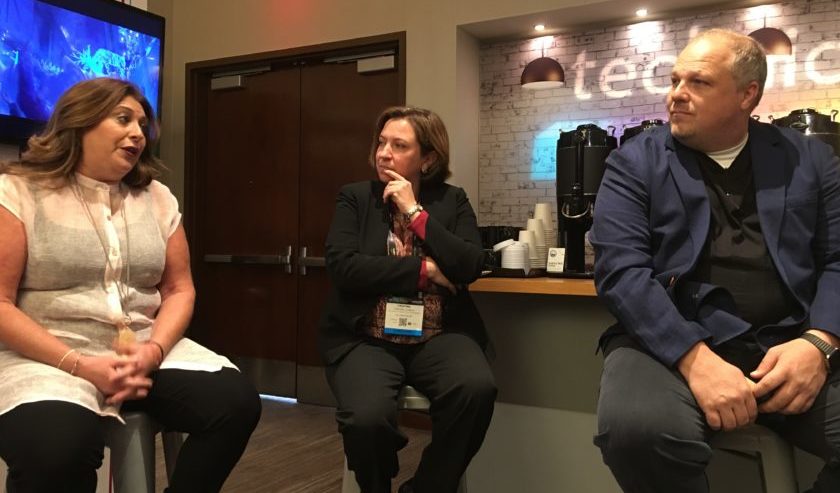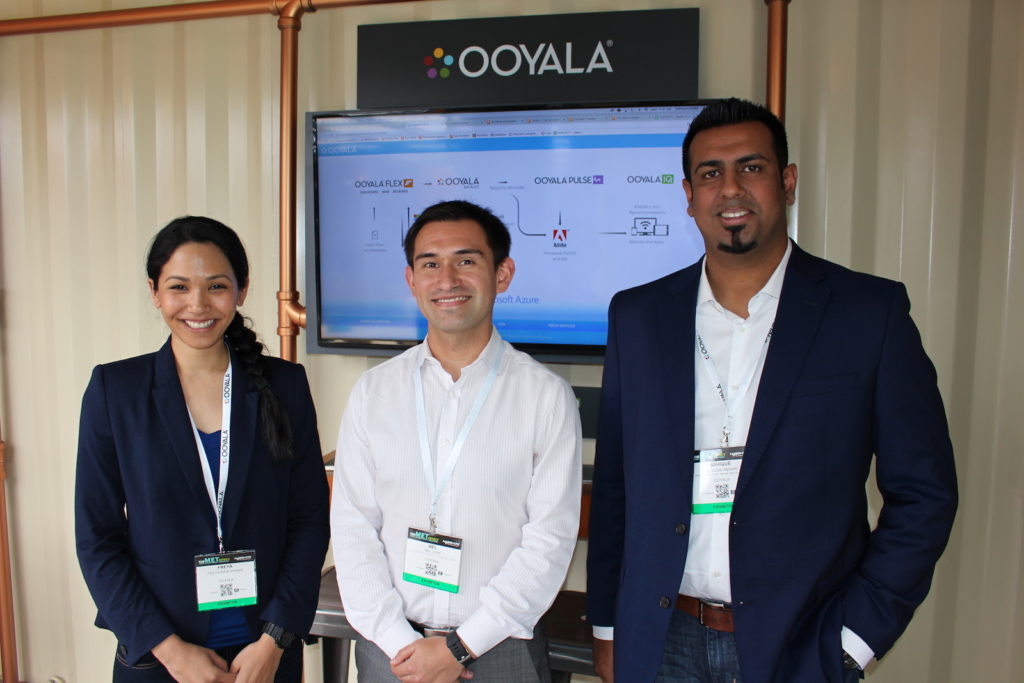Connections

NAB 2017: Technicolor Execs Talk VR, AR; Ooyala, Adobe Partner Up
Story Highlights
LAS VEGAS — The new generation of immersive experiences that have been created by augmented reality (AR), virtual reality (VR) and mixed reality offers new opportunities to create, distribute and consume entertainment content, according to Technicolor. But executives from the company said at the NAB Show April 24 that all members of the industry must continue working together to overcome remaining challenges that stand in the way of true success for those new experiences.
The development of a “value chain” is required that will “generate economic opportunities for artists, technologists, and the supporting cast of network service providers, and equipment manufacturers who have a stake in bringing these new experiences to consumers in an affordable and profitable manner,” according to Technicolor, which demonstrated some of the solutions it’s offering in the sector.
“If these experiences don’t get into peoples’ possession in some way, in an economical and affordable fashion, we’re going to have a difficult time creating an ecosystem that creates revenue opportunities for the entire value chain,” Lance Cooper, Technicolor VP of corporate communication, said during a briefing with reporters.
The overall immersive experience market, including AR, VR and mixed reality, remains a very nascent market, Marcie Jastrow, Technicolor SVP of immersive media and head of the new Technicolor Experience Center, said. “I don’t see it as widespread at all.”
“There’s a lot of us that are in VR and AR that kind of huddle together and think that the whole world knows what’s going on” with the technologies, she said. But she added: “I don’t think we’re quite there yet. The technology is still pretty rough, and delivering these experiences to headsets is not easy. Workflows are not fully there yet.”
The Technicolor Experience Center, announced last year, is opening in Culver City, California, June 15, and was designed to solve many of the challenges facing immersive entertainment experiences, she said.
Mixed reality is the next step beyond AR and VR, Cristina Gomila, CTO and head of research and innovation at Technicolor, said. She explained that mixed reality is achieved “when you really embed digital objects into the real world and they become natural.”
Achieving that, she said, is “our most long-term challenge,” conceding it’s not something that is not going to be finalized overnight because there are technical challenges that still need to be solved.
“Immersive is more than just headsets,” Gomila went on to say. For one thing, to make immersive content a true social experience, it’s important that users see the same things that their friends are seeing at the same time, she said.
Another issue that must be dealt with is compatibility when incorporating these immersive technologies into older architectures of legacy service providers including cable companies, she noted. “Immersive media will come in many different flavors” — some of them that “will be compatible” with the older systems, she said. But she added: “As we become more ambitious, changes will have to happen.”
One technical issue that’s still important to overcome in social immersive interactions is delays, she also said, pointing to latency – an issue that online game companies have been dealing with for many years.
“Everybody will have to talk,” she went on to say, adding: “We have to make sure that, end-to-end, everybody contributes to find solutions that assure interoperability” with multiple platforms and devices, as well as a “seamless experience” for those consuming content.
Also at NAB:
Ooyala announced at NAB that its Integrated Video Platform (IVP) solutions are now being integrated with the Adobe Experience Cloud, giving media and entertainment companies the ability to build better digital TV and OTT solutions that offer new insights across video production, distribution and advertising.
The goal of the partnership is to help customers reduce cost-of-ownership, and have them investing less in custom engineering and development services. “Video is unquestionably the crux of the digital transformation for the global media and entertainment market,” said Kevin Towes, Adobe’s media and entertainment head of business development.
 “As Ooyala leverages Adobe technology, we can help media companies achieve their transformation faster, with greater video monetization, engagement and measurement.”
“As Ooyala leverages Adobe technology, we can help media companies achieve their transformation faster, with greater video monetization, engagement and measurement.”
Belsasar Lepe, Ooyala co-founder and SVP of products and solutions, added: “Modern media companies with large audiences and real skin in the game need better insights and technologies to recognize greater return on their video business. Pairing our IVP solutions with Adobe gives even more insight into analytics and measurement, building common data sets across every function of video all with a single goal — to grow your business.”
BeBop Technology
BeBop announced it was releasing a multi-cloud post-production solution, one that’s fully integrated with Amazon Web Services (AWS), Microsoft Azure and IBM SoftLayer.
“Media and entertainment drives innovation in the public cloud sector and always will, and multi-cloud strategies are essential because the ways the industry has to use public Clouds are the most niche,” said BeBop Technology CEO and co-founder Bruce K. Long. “BeBop has been ahead of the curve for two years, developing a unique, complete solution that manages the complexities of integrating cloud services into production, distribution, and broadcasting, enabling our customers to focus on what they do best — making movies, TV, and digital content.”
BeBop’s post-production portal will offer industry-standard tools to virtualize workflows, and promises to enable content to be ingested, cataloged and organized, and with customers able to edit, process, render, and manage assets using an internet connection as slow as 20 Mbps.
G-Technology
G-Technology and Western Digital shared their latest, enhanced storage solutions, with upgrades to G-Technology’s Thunderbolt 3 and USB-C connectivity technologies, with optimized speed and performance for those drives.
“G-Technology recognizes the need for a complete workflow solution that takes advantage of the power of Thunderbolt 3 and USB-C,” said Sven Rathjen, VP of marketing and client solutions for Western Digital. “The result is a substantial upgrade across several product lines that delivers reliable, fast, and easy-to-use storage solutions to fit the current and future needs of our customers.”
The drives are intended specifically for creative professionals, including videographers and digital photographers, who need storage solutions that can handle intensive data needs and creative applications.
“As a photographer and explorer who loves on-location shooting, I only bring the gear I can rely on for storing the moments I work so hard to capture, and that includes the G-Technology drives,” said Lucas Gilman, an award-winning professional photographer. “In the field and in my studio, I also need lightning-fast transfer speeds, and that’s what G-Technology delivers. These new G-Technology drives are at the core of my workflow, allowing me to focus on capturing and preserving my creativity.”
FreeCast’s Cloud Entertainment Platform manages over 2 million pieces of content globally, and facilitates consumer access to free and ad supported streaming content, premium VOD services, pay-per-view shows and movies, and virtual pay-TV “skinny bundles” through SelectTV. These services will be joined, not replaced, by à la carte television channels in the company’s SmartGuide. With this addition, SelectTV continues to deliver unlimited entertainment choices to consumers on all of their devices.
Evolution Digital
Evolution Digital and Conax touted their recently announced partnership, which has the latter deploying a multi-DRM security platform on eVUE-TV, the former’s IP VOD, IP linear channel, network DVR and catch-up TV service.
“We have partnered with Conax to offer a best of breed comprehensive content security solution to our NCTC members with eVUE-TV,” said Brent Smith, president and CTO of Evolution Digital. “As cable operators move to IP distribution and begin offering a wide-range of content that can be viewed anywhere, Evolution Digital is committed to delivering content securely and providing operators with a low cost and hassle-free solution that eliminates complexities of technology integration.”
Adobe
Adobe used NAB to share the results of its “State of Digital Video” report, which has data from more than four billion TV Everywhere (TVE) authentications in North America, along with more than 300 sites and apps.
The report found that the mobile share of TVE viewing video content dropped below 50% in January, the first time in a year that’s happened. Adobe found that 32% of TVE viewing was on TVs, up from 20% two years ago, and ahead of browser viewing for the first time. And how people watch depends on the time of day and the programming.
“While mobile is the device of choice during day and primetime, consumers are turning to TVCDs during the evening; combined, the two account for over 75% of all video starts,” the report reads. “Weekdays account for 64% of video starts; during the week half of all TVE activity is in the evening and primetime slots (peaking at 9 p.m.).”











